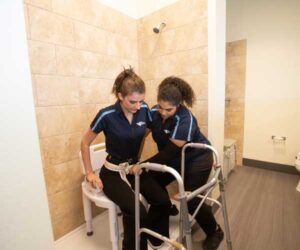No day is the same for occupational therapy assistants (OTA) and the places they can work are unique too. Their job duties consist of helping patients of all ages and with all different types of disabilities and challenges, learn how to participate in everyday life activities.

OTAs often work in rehabilitation clinics or hospitals. But, did you know these healthcare professionals can be found in many other work environments? If you’re interested in the field but not sure where you’d like to work, check out five options below.
- Home Health. OTAs can deliver personalized therapy services to clients in their homes, enabling the patient to navigate their environments safely and effectively. This is great for patients who feel comfortable in their own homes and can learn the skills they need to perform their routines and activities. The OTA will come up with a plan based on how the patient’s home is set up as well as help them learn how to use devices and tools to help with daily tasks.
- Schools. OTAs work in schools to assist children in developing fine motor skills, improving classroom performance and promoting social integration. They also help them adapt to their school environment and give them methods to use school equipment such as pens and pencils, computers and so on. The OTA’s ultimate goal is to help the student participate as much as possible in the school setting with meaningful activities that promote physical and mental well-being and for the student to be able to integrate with the rest of the student body.
- Ergonomic Specialist. This is a very unique option for an occupational therapy assistant. More and more office managers are realizing the harmful effects their employees endure from sitting at a desk all day. OTAs are sometimes brought in to observe how people are interacting while at their desks, working on their computers and observing their surroundings to uncover sources of strain and injury. After the OTA discovers the issues, they suggest exercises and postures to alleviate the strain as well as suggest ergonomic furniture and equipment to use.
- Assisted Living or Halfway Homes. OTAs help people learn how to live their lives independently at both of these residential environments. . This can include teaching them how to cook, pay their bills, practice personal hygiene care, apply for jobs and other basic tasks. They act as a guide for people who are returning back to daily life after spending and extended amount of time at an institution. For the assisted living facilities/nursing homes specifically, OTAs support elderly residents in maintaining their independence and improving their quality of life through tailored therapeutic activities.
- Contract Therapy. In this role, occupational therapy assistants work in various clinical settings as a contracted employee for a certain amount of time. This is a great opportunity to interact with various patients, settings and other OTAs and clinicians as well as expand your knowledge while being paid for it.
If you’d like to help people better their lives and learn how to live independently, consider a healthcare career as an occupational therapy assistant. This rewarding field offers the chance to make a meaningful impact on individuals’ lives across diverse settings providing many job opportunities. Get started at Pima Medical today!



